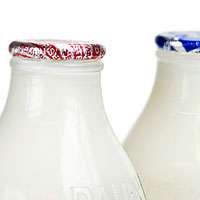Whole-fat milk consumption associated with leaner children, research finds

Children who drink whole milk are leaner and have higher vitamin D levels than those who drink low-fat or skim milk, new research suggests.
Children who drank whole (3.25 per cent fat content) milk had a Body Mass Index score that was 0.72 units lower than those who drank 1 or 2 per cent milk in the study published today in the American Journal of Clinical Nutrition.
That's comparable to the difference between having a healthy weight and being overweight, said lead author Dr. Jonathon Maguire, a pediatrician at St. Michael's Hospital.
The study did not assess why consuming higher fat content milk was associated with lower BMI scores. But Dr. Maguire hypothesized that children who drank whole milk felt fuller than those who drank the same amount of low-fat or skim milk. If children don't feel full from drinking milk, they are more likely to eat other foods that are less healthy or higher in calories, said Dr. Maguire. Therefore children who drink lower fat milk may actually consume more calories overall than those who drink whole milk.
The study also found that children who drank one cup of whole milk each day had comparable vitamin D levels to those who drank nearly 3 cups of one per cent milk. This could be because vitamin D is fat soluble, meaning it dissolves in fat rather than water. Milk with higher fat content therefore contains more vitamin D. There may also be an inverse relationship in children between body fat and vitamin D stores, according to the study; as children's body fat increases, their vitamin D stores decrease.
"Children who drink lower fat milk don't have less body fat, and they also don't benefit from the higher vitamin D levels in whole milk," said Dr. Maguire. "It's a double negative with low fat milk."
The study's findings differ from Health Canada, National Institutes of Health and American Academy of Pediatrics guidelines recommending two servings of low fat (one per cent or two per cent) milk for children over the age of two to reduce the risk of childhood obesity.
Dr. Maguire said the findings indicated a need to closely examine existing nutritional guidelines around milk fat consumption to make sure they are having the desired effect. Childhood obesity has tripled in the past 30 years while consumption of whole milk has halved over the same period.
"What kind of milk our children should be consuming is something we need to seek the right answer for," said Dr. Maguire.
For this study, researchers studied 2,745 children ages two to six years attending well-child visits. They surveyed parents, measured height and weight to calculate BMI and took blood samples to assess vitamin D levels. All were enrolled in the Applied Research Group for Kids (TARGet Kids!), collaboration between children's doctors and researchers from St. Michael's Hospital and The Hospital for Sick Children. The program follows children from birth with the aim of preventing common problems in the early years and understanding their impact on health and disease later in life.
Of those studied, 49 per cent drank whole milk, 35 per cent drank two per cent milk, 12 per cent drank one per cent milk and four per cent drank skim milk. Less than one per cent of children drank some combination of the four types of milk.

















